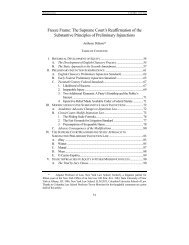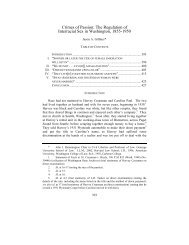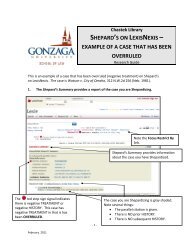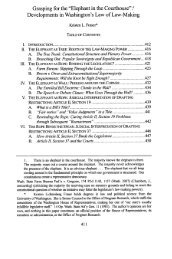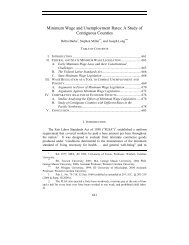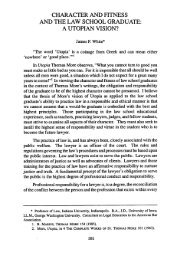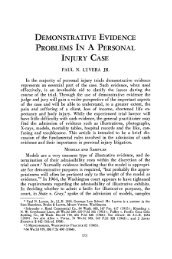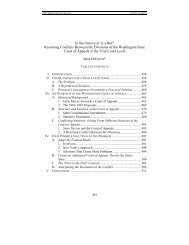professional responsibility, student practice, and the clinical
professional responsibility, student practice, and the clinical
professional responsibility, student practice, and the clinical
Create successful ePaper yourself
Turn your PDF publications into a flip-book with our unique Google optimized e-Paper software.
1990/91]<br />
STUDENT PRACTICE<br />
in a non-educational setting, also has an explicit pedagogical <strong>responsibility</strong><br />
to <strong>the</strong> <strong>student</strong>. That <strong>responsibility</strong> may vary as a function of curriculum <strong>and</strong><br />
<strong>clinical</strong> program design but, at its core, it means <strong>the</strong> <strong>clinical</strong> teacher values<br />
<strong>and</strong> addresses <strong>the</strong> <strong>student</strong>s' educational needs <strong>and</strong> expectations as a<br />
substantial <strong>and</strong> independent set of <strong>professional</strong> concerns. 1<br />
The supervising attorney in <strong>the</strong> non-clinic setting may seek to fur<strong>the</strong>r a<br />
law <strong>student</strong> employee's education ei<strong>the</strong>r out of genuine concern or because<br />
it is in <strong>the</strong> employer's business interest to do so. However, it is likely <strong>the</strong><br />
effort will be incidental to <strong>the</strong> employer's principal goal of servicing clients<br />
<strong>and</strong> will lack <strong>the</strong> structure <strong>and</strong> methods necessary to address <strong>the</strong> <strong>student</strong>'s<br />
individual educational needs. 12 Clinical teaching, on <strong>the</strong> o<strong>the</strong>r h<strong>and</strong>, is<br />
distinguished by <strong>the</strong> very fact that educating <strong>student</strong>s is <strong>the</strong> business of <strong>the</strong><br />
clinic. 3<br />
11. See Barnhizer, The Clinical Method of Legal Instruction: Its Theory <strong>and</strong><br />
Implementation, 30 J. OF LEGAL EDUC. 67, 72 (1979). Barnhizer warns that mere exposure<br />
of law <strong>student</strong>s to <strong>the</strong> experience of client representation <strong>and</strong> <strong>responsibility</strong> is, in itself, an<br />
unreliable teaching method which presents unjustifiable risks for clients <strong>and</strong> for <strong>student</strong>s.<br />
He argues that <strong>the</strong> <strong>clinical</strong> method must integrate <strong>the</strong> following three factors: (1) a<br />
substantive, but restricted, volume of actual client representation by <strong>the</strong> <strong>student</strong>; (2) <strong>the</strong> clear<br />
assumption by <strong>the</strong> individual <strong>student</strong> of "primary" <strong>professional</strong> <strong>responsibility</strong> for <strong>the</strong> process<br />
<strong>and</strong> outcome of that representation; <strong>and</strong> (3) an individualized teaching relationship between<br />
<strong>the</strong> <strong>student</strong> <strong>and</strong> clinic teacher, using <strong>the</strong> <strong>student</strong>'s <strong>clinical</strong> experience as its focus. See<br />
generally Stone, Legal Education on <strong>the</strong> Couch, 85 HARV. L. Rnv. 392, 431-36 (1971);<br />
Kreiling, supra note 1; Hoffman, supra note 1.<br />
12. Meltsner, Rowan, <strong>and</strong> Givelber examine <strong>the</strong> problem of inadequate supervision<br />
of junior lawyers in big city law firms. Based on interviews with a number of supervisors<br />
<strong>and</strong> supervisees in large <strong>and</strong> mid-size private firms, <strong>the</strong> authors conclude that many law<br />
firms do not pay significant attention to <strong>the</strong> process by which new lawyers learn on <strong>the</strong> job.<br />
The reasons for such inattention include <strong>the</strong> cost <strong>and</strong> pace of modem legal <strong>practice</strong> (which<br />
run counter to reflective supervision) <strong>and</strong>, interestingly, <strong>the</strong> failure of legal education to<br />
identify effective supervision as a matter that belongs in <strong>the</strong> curriculum. Meltsner, Rowan<br />
& Givelber, The Bike Tour Leader's Dilemma-Talking About Supervision, 13 VT. L. REV.<br />
399 (1989). See also Henning, The Lawyer as Mentor <strong>and</strong> Supervisor, LEGAL ECON., Sept.-<br />
Oct. 1984, at 20, 21. Henning believes it is difficult for <strong>the</strong> task-oriented lawyer<br />
"supervisor" to also be a trusted "mentor," i.e., one who counsels <strong>and</strong> teaches.<br />
13. I am not suggesting that working part-time as a clerk or intern during law school<br />
is necessarily harmful. It may be educationally beneficial to law <strong>student</strong>s, particularly those<br />
who lack an opportunity for skills training in law school courses <strong>and</strong> who are fortunate<br />
enough to be "mentored" by an employer supervisor who focuses on <strong>the</strong> <strong>student</strong> as well as<br />
<strong>the</strong> task. See Pipkin, Moonlighting in Law School, AM. B. FOUND. RES. J. 1109, 1162<br />
(1982); Zillman & Gregory, Law Student Employment <strong>and</strong> Legal Education, 36 J. LEGAL<br />
EDUC. 390 (1986).



